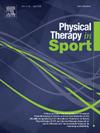Relationship between single-leg balance, single-leg hop, and agility running performance in female field hockey players: Implications for lower extremity injury prevention screening
IF 2.2
3区 医学
Q1 REHABILITATION
引用次数: 0
Abstract
Objectives
In field hockey, there is limited information regarding lower extremity (LE) injury prevention screening protocols. To help inform the design of field hockey LE injury prevention screening protocols, the purpose of this study was to investigate whether static and dynamic single-leg balance (SLB), single-leg hop (SLH), and agility running tasks with unilateral limb-loading bias capture similar or different aspects of LE motor performance.
Design
Cross-sectional.
Setting
Indoor training facility.
Participants
Thirty adult female players.
Main outcome measures
For the right and left LE, Pearson's correlations (r) and the coefficient of determination (r2) assessed between-task relationships and shared variance, respectively, for: eyes-closed SLB, Star Excursion Balance Test – anterior reach, triple-hop-for-distance, 6-m-hop-for-time, modified pro-agility test.
Results
Across all correlations, 50% were not statistically-significant. Statistically-significant (P < 0.05) relationships were returned for the right LE (r = −0.69 to 0.42, r2 = 0.17 to 0.48) and left LE (r = −0.62 to 0.53, r2 = 0.17 to 0.38). Overall, between-task shared variance was ≤48.0%.
Conclusions
Because between-task shared variance was ≤48.0%, static and dynamic SLB, SLH, and agility running tasks with unilateral limb-loading bias each assess different aspects of LE motor performance. Therefore, practitioners should incorporate a range of LE motor performance tasks when designing field hockey LE injury prevention screening protocols.
女子曲棍球运动员单腿平衡、单腿跳和敏捷跑表现的关系:对下肢损伤预防筛查的意义
目的在曲棍球运动中,关于下肢损伤预防筛查方案的信息有限。为了帮助曲棍球LE损伤预防筛查方案的设计,本研究的目的是调查静态和动态单腿平衡(SLB)、单腿跳跃(SLH)和单侧肢体负荷偏倚的敏捷跑步任务是否捕获了LE运动性能的相似或不同方面。室内训练设施。参与者:30名成年女性选手。主要结果测量:对于左右LE, Pearson相关系数(r)和决定系数(r2)分别评估了任务间关系和共享方差:闭眼SLB,星偏移平衡测试-前伸,三跳距离,6米跳时间,改进的前敏捷性测试。结果在所有相关性中,50%无统计学意义。统计学显著性(P <;右侧LE (r = - 0.69 ~ 0.42, r2 = 0.17 ~ 0.48)和左侧LE (r = - 0.62 ~ 0.53, r2 = 0.17 ~ 0.38)的相关性均为0.05)。总体而言,任务间共享方差≤48.0%。结论由于任务间共享方差≤48.0%,静态和动态SLB任务、SLH任务和单侧肢体负荷偏倚的敏捷跑步任务各自评估LE运动表现的不同方面。因此,从业者在设计曲棍球LE损伤预防筛查方案时应纳入一系列LE运动表现任务。
本文章由计算机程序翻译,如有差异,请以英文原文为准。
求助全文
约1分钟内获得全文
求助全文
来源期刊

Physical Therapy in Sport
医学-康复医学
CiteScore
4.50
自引率
8.30%
发文量
125
审稿时长
39 days
期刊介绍:
Physical Therapy in Sport is an international peer-reviewed journal that provides a forum for the publication of research and clinical practice material relevant to the healthcare professions involved in sports and exercise medicine, and rehabilitation. The journal publishes material that is indispensable for day-to-day practice and continuing professional development. Physical Therapy in Sport covers topics dealing with the diagnosis, treatment, and prevention of injuries, as well as more general areas of sports and exercise medicine and related sports science.
The journal publishes original research, case studies, reviews, masterclasses, papers on clinical approaches, and book reviews, as well as occasional reports from conferences. Papers are double-blind peer-reviewed by our international advisory board and other international experts, and submissions from a broad range of disciplines are actively encouraged.
 求助内容:
求助内容: 应助结果提醒方式:
应助结果提醒方式:


